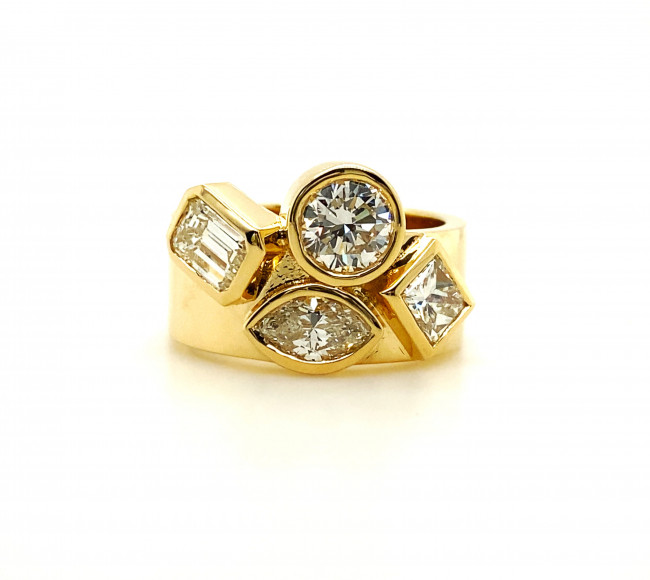
Table of Contents
In this Bling Advisor article, we will review the correlation between diamond shapes and prices.
How Does Diamond Shape Affect Price?
A variety of elements determines the price of a diamond. One of these factors is the shape, also known as the cut; different shapes cost different prices as they have different characteristics that make them more or less desirable for certain people.
Other factors that might affect a diamond’s price are size, scintillation, pattern, and brilliance.

Why does Diamond Price vary depending on its shape?
There are many different diamond shapes, each with a different price range.
Different diamond shapes provide different characteristics that suit different purposes. Grooms and brides looking for engagement rings will prefer specific shapes and therefore be willing to pay more for them. That alters the demand, which in turn alters the price of that particular shape.
Generally speaking, the more rare a diamond shape is, the higher its price will be because people value things that aren’t easily accessible and lack many substitutes. That is true for diamonds as well as many other things.
This article lists the 11 most common diamond shapes, from the most popular and expensive to the most affordable diamond cut.
What is a brilliant-cut diamond?
A brilliant-cut diamond refers to a diamond that has received a specific cut to increase the amount of light reflected through the top of it. Due to this, brilliant-cut diamonds have more sparkle and brilliance than other diamonds. Because of this, they are very popular as engagement rings and therefore more expensive.
1- Round Brilliant Diamonds
The round shape diamond is also known as “the king of diamonds” and is the most popular diamond shape for three main reasons:
- Round brilliant diamonds need more raw material and polishing time than other shapes. The gem cutter removes up to 60% of the rough diamond to create a high-quality round diamond. A round brilliant diamond is also significantly more expensive than other diamond shapes because of its labor-intensive work.
- Round cut diamonds create the most sparkle and brilliance. Round-shaped diamonds have 58 facets that maximize the amount of light entering and leaving the diamond.
- Round-shaped diamonds are very desirable, and their demand is higher than any other diamond shape. It is the most popular shape for engagement rings due to its brilliant look and intense sparkle. About 50% of diamonds sold are brilliant round diamonds.
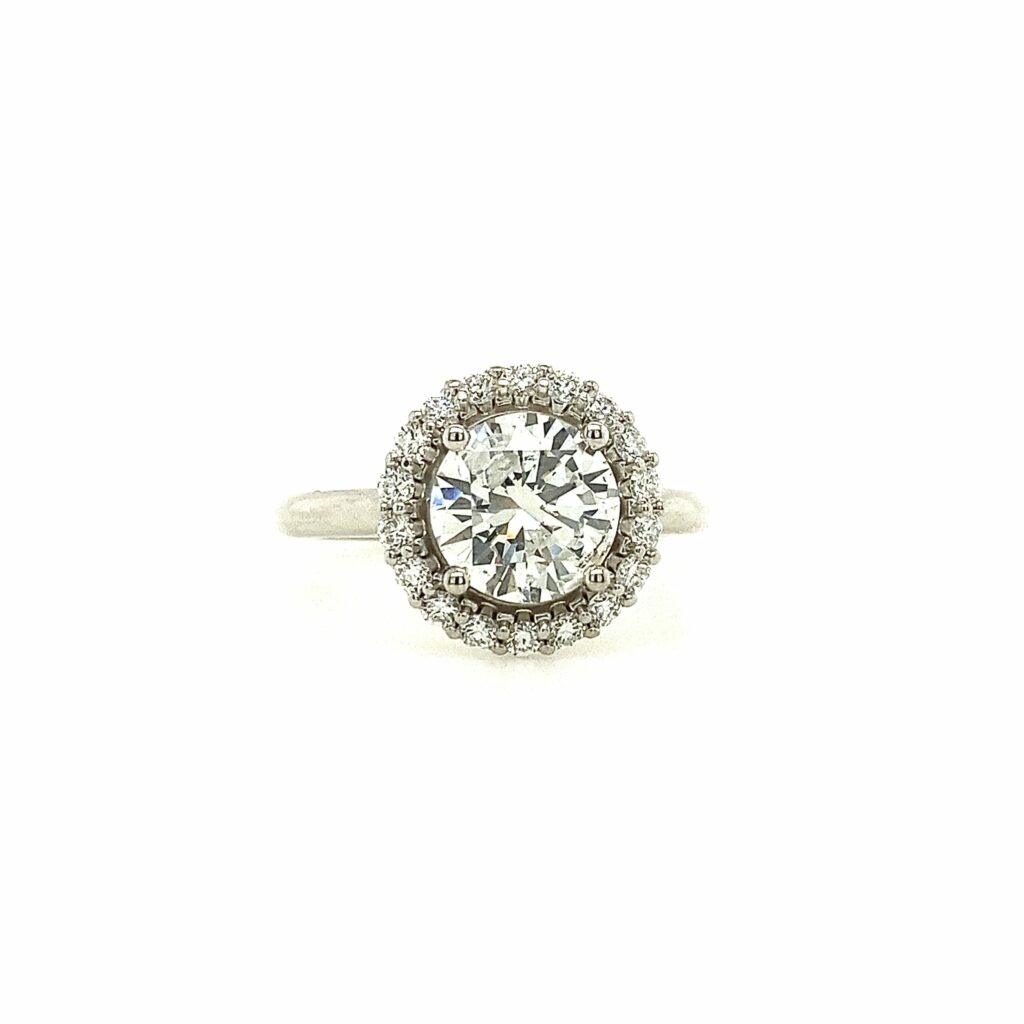
Astonishing Round Diamond Halo Ring
If you’re looking for a gift that will truly take her breath away, look no further than this stunning Asscher Teal Sapphire Pendant Necklace! The center stone is a magnificent 1.20 ct Asscher cut unheated teal sapphire, accented by 11 round diamonds set in 14k white gold. It comes on an 18-inch wheat chain and weighs 3.4 grams.
Sapphires are known for being durable and perfect for everyday wear, making this necklace an ideal gift she can enjoy wearing every day. It’s a truly unique piece that she’s sure to treasure forever.
2- Oval Cut Diamonds
Oval diamonds, also known as “egg-shaped diamonds,” are cut with a flat bottom and curved sides. Because of their elongated shape, they appear more significant for their carat weight. This adds to their surge in popularity because they look much bigger than a round diamond of the same carat weight. Oval-cut diamonds didn’t become popular until the late 20th century when they became the diamond shape of choice for many celebrities such as Princess Diana or Catherine Zeta-Jones.
Oval-cut diamonds are gaining popularity right behind round diamonds and lead the market in gain. Light performance is an advantage for oval cut diamonds as they have a large surface area for all that sparkle to reflect. They’re 10-20% less than rounds, with about 8% larger face-up area!
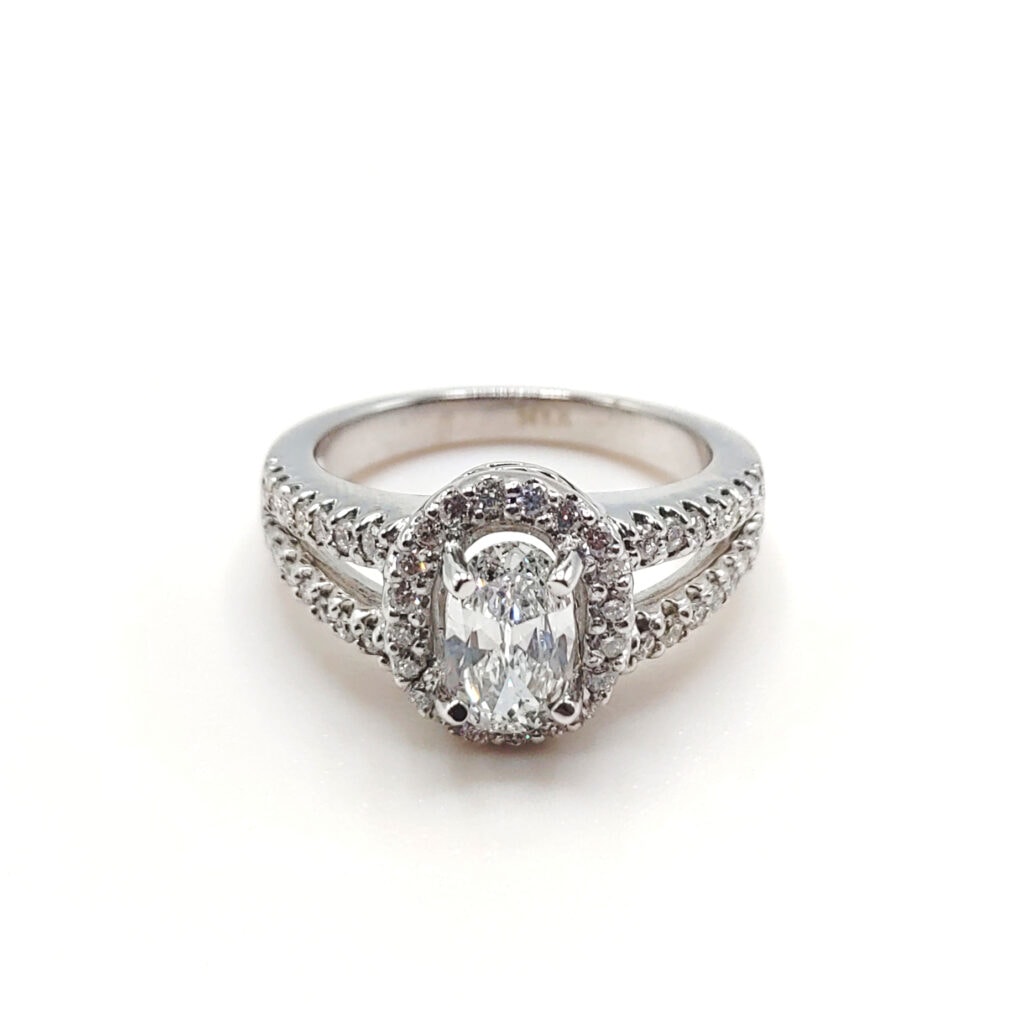
Stunning Oval Diamond Halo Engagement Ring
This breath-taking oval cut diamond ring with 50 accent diamonds, makes it an exquisite ring fit for a fashionista! Featuring a dazzling oval diamond centerpiece of .69 carats with excellent ratings for color and clarity, this ring is sure to impress.
3- Emerald Cut Diamonds
The emerald-cut diamond is an elegant and sophisticated choice for engagement rings or any other jewelry piece that you want to create. Emerald-cut diamonds offer a great alternative to the traditional round cut. The Emerald Cut Diamond flaunts an elongated, rectangular shape and chiseled step cuts, with straight linear facets—usually arranged parallelly down the stone, as they have a unique rectangular shape. The corners of an Emerald Cut Diamond are usually cropped to add stability and prevent fractures.
Emerald cuts come in various sizes, which allows you to find one that perfectly fits your style. Emerald Cuts are more prominent in rectangular shapes but are also available in squares.
It is a popular choice for those wanting a larger stone without a high price point, making them up to 20% more affordable than round diamonds while having the same carat weight.

Split Shank Emerald Cut Yellow Diamond Ring
This stunning split shank emerald cut yellow diamond ring is a showstopper. An emerald-cut yellow diamond ring is both classic and non-traditional. If you’re looking for a unique and dazzling ring that will make a statement, look no further!
4- Cushion Cut Diamonds
The cushion cut diamond is a particular variant of the brilliant round cut. The cushion-cut diamond has rounded corners and resembles a pillow.
Cushion-cut diamonds are gaining popularity as a choice for engagement rings. They’re popular in Europe but aren’t as sought after in the United States. Cushion-cut diamonds look bigger than they are and make an excellent choice for women who seek diamonds that appear larger. They come in various sizes, so you can find one which perfectly fits your style.
Compared to other diamond cuts, cushion-cut diamonds have fewer and bigger facets. This way, the light reflects and refracts mostly through their corners and edges than through their table or pavilion. Cushion cuts cost about 10-20% less than their round equivalents. They have around 60% of their carat weight represented by their surface, which means they offer great value for money.
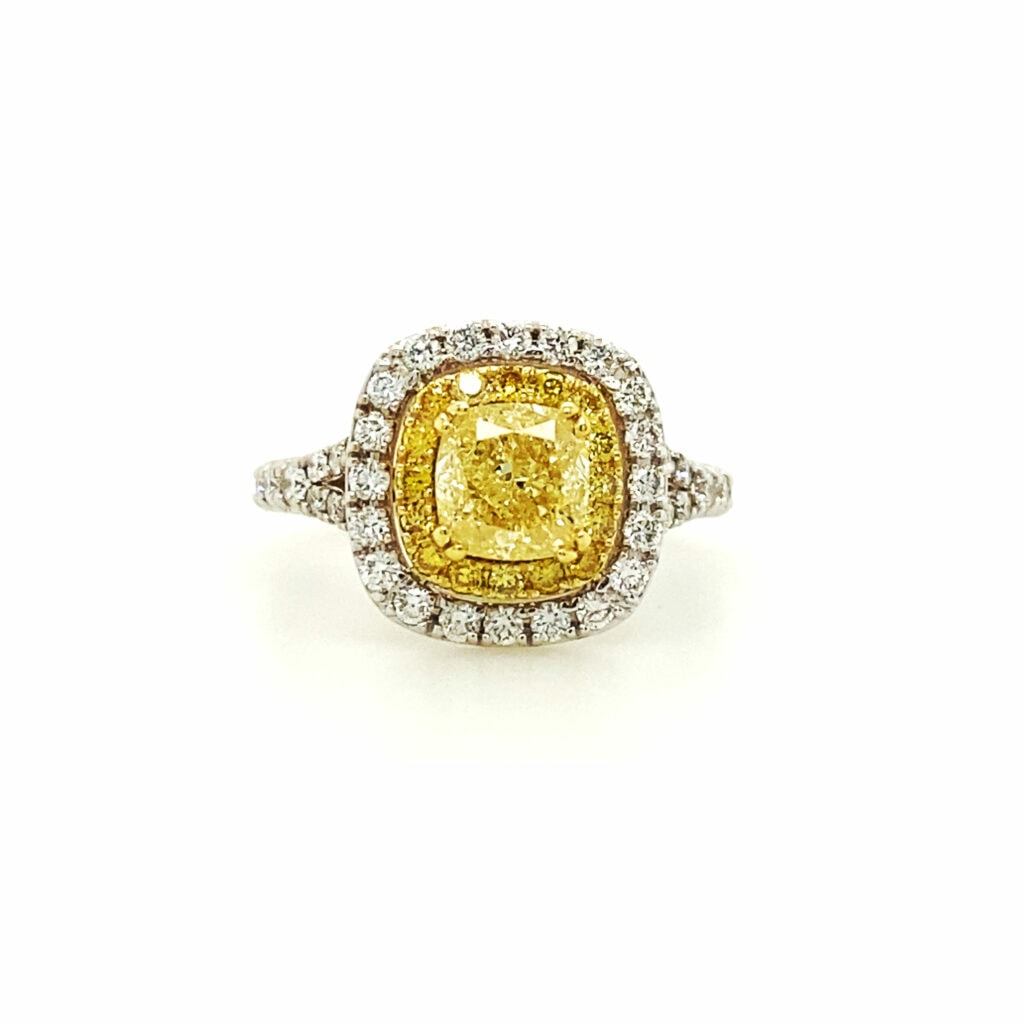
Split Shank Cushion Cut Yellow Diamond Ring
Make a grand entrance with this Cushion Cut Yellow Diamond Ring. The center fancy light yellow diamond is surrounded by 16 round, dazzling fancy yellow accents in the halo, and set in 18k yellow gold. There are an additional 46 white round diamonds surrounding the shank which is set in 14k white gold. Whether you’re looking for an engagement ring with pizzazz or a unique piece to add to your jewelry collection, this ring is sure to impress.
5- Radiant Cut Diamonds
Henry Grossbard is credited with the design of the radiant cut in 1977. in pursuit of combining the finest elements of the round brilliant cut and the emerald cut.
The radiant cut diamond owes its brilliance to the 70 facets found in its pavilion and crown. The precision of each facet offers immense brilliance and fire. Although the radiant cut isn’t quite as brilliant as the round brilliant cut, it’s not very far behind. Because of the 70 facets in its pavilion and crown, the radiant cut offers impressive brilliance and sparkle. This makes the radiant cut a great choice if you want a non-round diamond with a beautiful sparkle.
Radiant cuts are about 10-20% less expensive than round diamonds of similar weights. Due to their large surface area, they get a high refractive index, making them look larger and more brilliant.
6- Pear Cut Diamonds
Pear cut diamonds have a unique elongated shape with rounded ends, which resembles the shape of a pear. Pear-cut diamonds are not as popular as round or other fancy cuts, but their distinctive look makes them very appealing.
Pear-shaped diamonds usually have 57 facets which give them great fire and sparkle. Compared to round diamonds, pear-shaped diamonds have a larger surface area and are 10-20% less expensive without compromising quality.
Pear-shaped engagement rings look great for women with long fingers, and their elongated shape makes them appear more prominent than rounds.
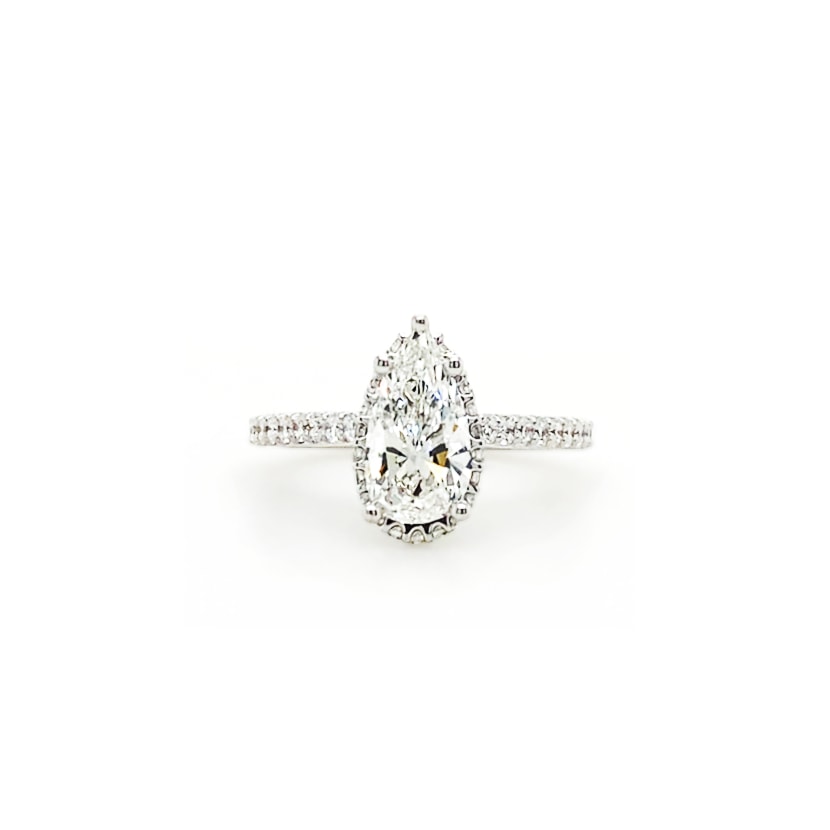
7- Princess Cut Diamonds
The princess cut diamond is a square (or near-square) brilliant-cut introduced in the late 1980s. Princess cut diamonds feature sharp edges and corners compared to other diamond shapes. The name princess cut comes from the shape’s resemblance to a castle’s towers and turrets. It is cut to maximize the brilliance and fire of the diamond.
The princess cut diamond is a popular choice for brides seeking alternative options to the traditional round cut diamond. This cut also can be 15-25% less expensive, making them an affordable choice.
Princess cut diamonds have a higher table percentage (60-75%) which means their surface facet is more prominent than average. The cut of princess diamonds has up to 78 facets that give the best combination of shape and fire.

Rose Gold Princess Cut Diamond Engagement Ring
Do you love white gold, rose gold, and beautiful sparkly diamonds? If so, then check out our new custom Bling Advisor creation!
If you’re looking for a romantic and timeless expression of love, look no further than this beautiful Rose Gold Princess Cut Diamond Engagement Ring.
This custom piece exquisitely infuses classic and contemporary aesthetics.
Featuring a stunning 1.67ct princess cut K-l color and VVS-2 clarity center diamond plus an array of 46 full-cut round accent diamonds set in a two-tone white gold and rose gold setting, this ring is sure to stand out from the crowd.
Currently sized for a finger size 6, inquire about resizing to make it personalized just for you!
8- Marquise Cut Diamonds
The marquise cut diamond is one of the most popular-shaped diamonds globally. The length of the diamond typically has a two to one length-width ratio, giving it an elongated shape. Marquise diamonds are typically cut with 57 facets (mainly on the pavilion), making them sparkle and shine to attract attention for their distinctive shape.
The price of marquise-cut diamonds varies depending on the length to width ratio and the diamond’s body (the part between the width and length). Marquise shapes are 10-25% more affordable than round diamonds of similar weight without compromising quality.
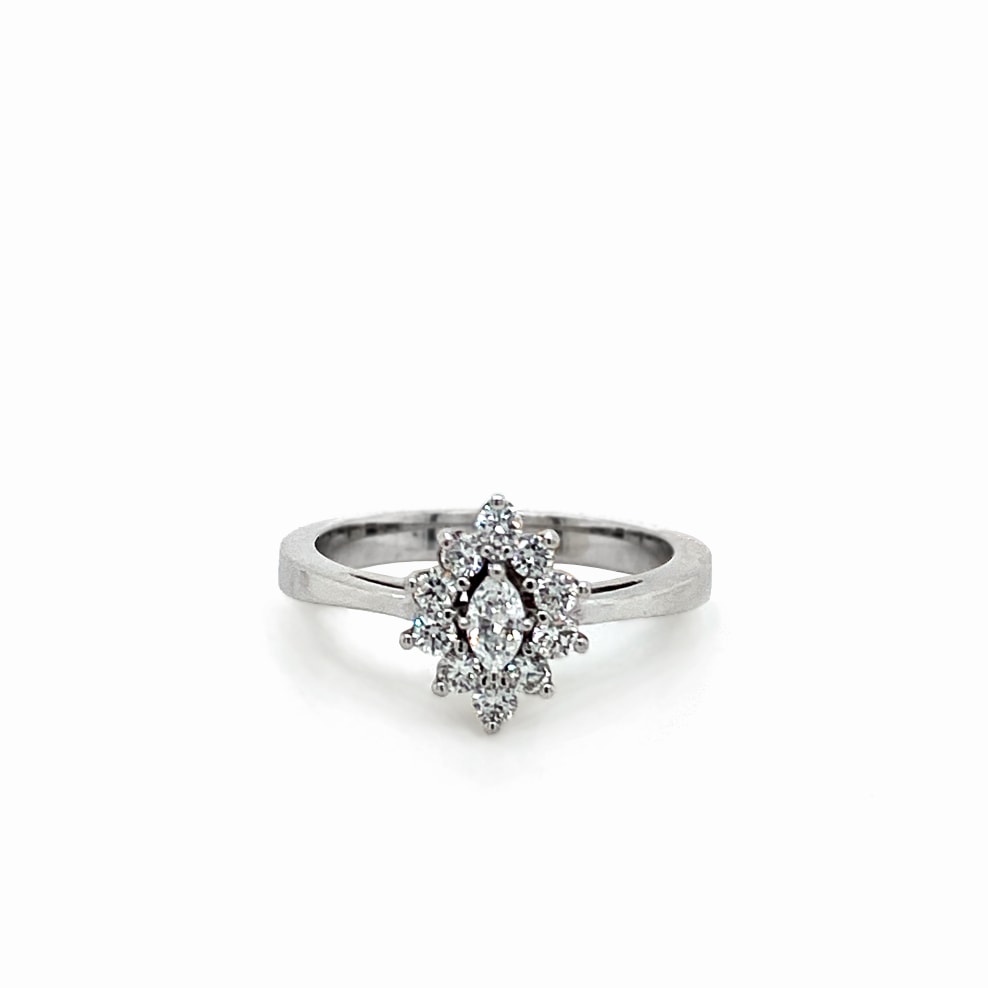
Marquise Halo Engagement Ring
This diamond halo fashion ring is sure to turn heads. The center marquise diamond engagement ring is surrounded by a halo of 10 round diamonds, making it sparkle and shine. It’s set in white gold and would look great on any finger.
9- Heart Cut Diamonds
The heart-cut diamond is another trendy choice for engagement rings. Heart-shaped diamonds are cut with 57 or 58 facets, making them sparkle and shine to give off maximum fire and brilliance that the eye can’t resist.
Heart-shaped diamonds are about 25% heavier and about 10-30% less expensive than round cuts of similar weights. They have a slightly larger surface area than round-shape diamonds, appearing larger.
Heart-shaped diamonds are recommended for people with shorter fingers as their shape may look bulky if they have longer fingers. They are very popular amongst women who wear rings on their right hand as the heart shape is always perceived as a symbol of love, commitment, and devotion.
10- Asscher Cut Diamonds
The Asscher-cut diamond is a cut that the Asscher Brothers first introduced in 1902, also known as “square emerald-cut diamonds,” the Asscher-cut diamond is very similar in appearance to an emerald-cut diamond.
Asscher cuts have a different faceting style similar to the emerald cut called step cuts that are layered, producing a mirrored effect. This makes them sparkle and shine differently than a brilliant cut. While the Asscher-cut diamond is very similar to an emerald-cut diamond in terms of faceting, it has a more rectangular shape than the emerald cut. Asscher-cut diamonds can also have higher crown heights, making them look heavy.
Asscher-cuts can be 10% to 15% more affordable than round diamonds while being about 14% larger.
Another shape comparable to Asscher cut is the Baguette cut.
11- Trillion Cut Diamonds
The trillion-cut diamond is a triangular diamond shape with three equal sides. The trillion cut can be found in both fancy shapes and colors.
A trillion diamond is a brilliant-cut diamond with 33 facets on the crown instead of the usual 57 or 58. Trillions come in many varieties, rounded corners, shield, concave, convex, curved cuts, uncurved. The variations are endless and often depend on the shape of the rough, giving them their unique look.
Trillion diamonds are less expensive than most other fancy-shaped diamonds due to their smaller surface area, even though they are brilliant. Trillions are about 15-20% smaller than their equal weight of round diamonds, making them popular amongst people who want the brilliance of a diamond without its size.
Trillion-cut diamonds are about 10-30% more affordable than round-cut diamonds. The price of trillion-cut diamonds also varies depending on the combined factors of the 4C’s of each stone.
Conclusion:
The essential factors in determining how much a diamond will cost are the 4Cs: carat, color, clarity, and cut. As you have seen, the diamond shape does affect its price.
Most importantly, consider the person, style, and occasion for which you are purchasing the diamond. Is your purchase for an engagement ring? You’ll want to make sure your fiance will be comfortable and excited to wear the diamond you select for decades.
In the end, considering the fundamentals of each diamond shape allows you to select what’s suitable for you or your loved one from a variety of options. Utilize this diamond shapes guide as you explore the best diamond shape for you on the internet or in stores.
